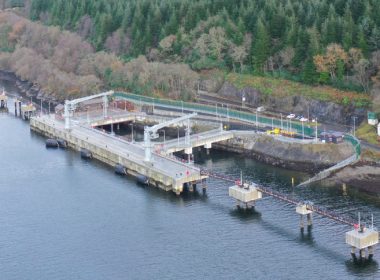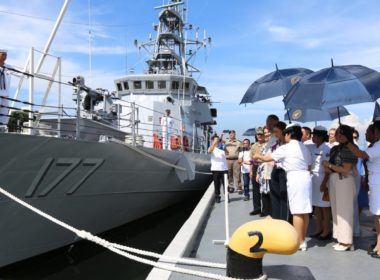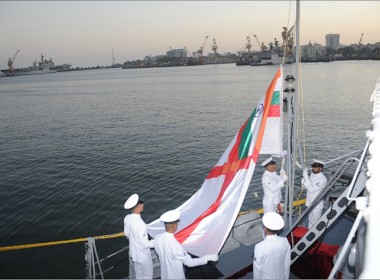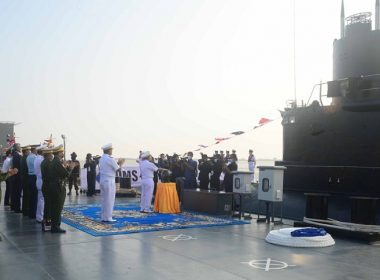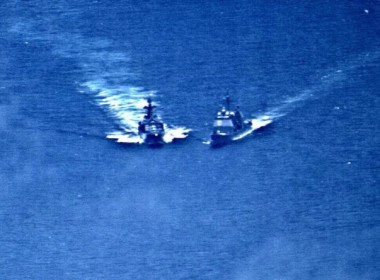OPINION | Navy chief Mark Hammond: With a well-designed campaign, surface warships can operate in a high intensity conflict

Over decades, a truism has matured that modern technology, surveillance systems and weapons have evolved to the point where surface warships will not survive in a high intensity conflict. So, given the major increase in the size and lethality of the Royal Australian Navy announced this week, how has that thinking changed?
Navy chief Vice Admiral Mark Hammond believes aspects of that theory are naïve and the reality is much more complicated. As one of Australia’s most experienced submariners, he backs the government’s decision to build a much more heavily armed and numerous fleet of surface warships.
“Ultimately when you talk about conflict you start with campaign design, and you play to your strengths. The US Navy knows this well,” says Hammond.
“You don’t send a bunch of surface ships into battle deliberately with a fleet of submarines backed up by long range missile capability. You have to degrade, disrupt and destroy an adversary’s targeting capability and their ability to strike you. And you must preserve those of your forces that are vulnerable.”
“When you get to operational campaigns, theatre campaigns and campaign design, you’ve got to play horses for courses.”
Hammond served on Australian submarines going back to the Oberons. He commanded a Collins-class submarine, and served on American, British, and French nuclear submarines. He graduated from the US command course in 2003 and spent five months on Netherlands’ Walrus-class submarines. That included exercises with Royal Navy SSNs, some in Scottish lochs.
He admits that his views have changed.
“Certainly, as a lieutenant I would’ve told you, ‘Look, two ships and a submarine equals a submarine.’ Most submariners will still tell you that. But when you get to operational campaigns, theatre campaigns and campaign design, you’ve got to play horses for courses.”
When he was on his submarine command course in UK waters, he was competing against a British Type 23 frigate. The Hunter-class frigate to be built for the RAN derived many of its capabilities from the Type 23.
“That thing was so quiet it could be sitting there on the surface and you wouldn’t know it was there until you returned to periscope depth and saw it. That’s the point with Hunter; she’s designed to be survivable in a submarine threat environment and she’s designed to have sufficient standard fight capability for the other threats.”
That survivability will only be enhanced, Hammond says.
“A fleet optimisation program has been underway for some time to ensure that ships’ capability would be improved to the best extent possible.”
Hammond started his career as an electronics technician at the age of 18. He was appointed chief of navy in July 2022 shortly after the new government was elected in an increasingly difficult strategic environment. Since then, the defence strategic review (DSR) has handed down its recommendations, the surface fleet analysis is complete, the pathway to nuclear-powered submarines (SSNs) has been developed under the AUKUS agreement with the US and UK, and plans are in train to secure the workforce needed to make it all happen.
So, what is being done to make the existing navy more lethal and survivable in case a conflict erupts before the new ships are ready and it must fight with what it’s got?
Hammond says a fleet optimisation program has been underway for some time to ensure that ships’ capability would be improved to the best extent possible. Upgraded weapons would include Tomahawk cruise missiles, and advanced sea mines had already been delivered.
The new general purpose frigates would come with strike capability and the Hunter-class anti-submarine warfare frigates could be fitted with Tomahawks as well, he says. I’ll say we’ve ruled out the OPV (offshore patrol vessel). It’s a constabulary vessel. It’s not designed to go into harm’s way. Its survivability is very low so we’ll keep her out of the mix, and we’ll focus on enhancing the Anzac-class frigates and the Hobart class destroyers and bringing the new capabilities online as quickly as we can.’
Deputy Prime Minister and Defence Minister Richard Marles announced that Navy’s future surface combatant fleet will comprise:
- Three Hobart-class air warfare destroyers with upgraded air defence and strike capabilities
- Six Hunter-class frigates to boost the navy’s undersea warfare and strike capabilities
- Eleven new general purpose frigates that will provide maritime and land strike, air defence and escort capabilities
- Six new large optionally crewed surface vessels (LOSVs) to significantly increase the navy’s long-range strike capacity
- Six remaining Anzac-class frigates with the two oldest ships to be decommissioned as per their planned service life
- 25 minor war vessels to contribute to civil maritime security operations, which includes six offshore patrol vessels (OPVs)
“The delivery of an enhanced lethality surface combatant fleet and sovereign shipbuilding industry will help secure Australia’s economic prosperity and trade, and help keep Australians safe,” said Marles.


